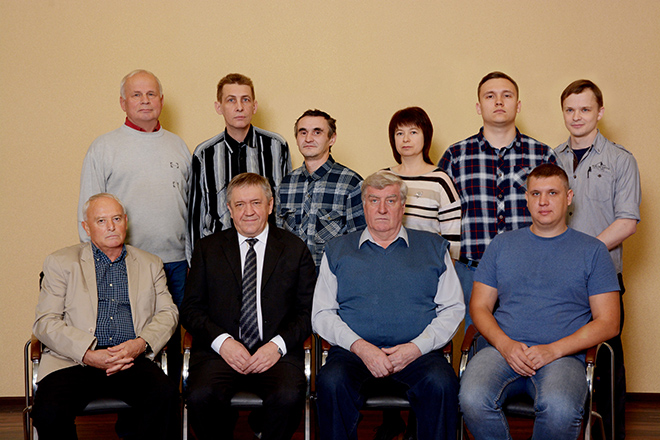
|
|---|
From left to right: top: N.A. Riabkov, A.V. Lubegin, F.F. Makhinko,
N.V. Guschina, E.V. Makarov, I.Yu. Romanov,
bottom: V.A. Ivchenko, V.V. Ovchinnikov, V.A. Semenkin, S.V. Ovchinnikov (2017, November)
Laboratory of Beam Actions was established in 1990 by the decision of the Director of the Institute, Academician G.A. Mesyats with the active support of the Deputy Director of the Institute prof. Yu.E. Kreyndel with the aim of conducting fundamental and applied research on the effect of powerful beams of charged particles on a substance using the new accelerator technology developed at the Institute. In particular, it was supposed to work on modeling the effects of reactor neutrons on metals, alloys and structural materials based on them.
At present, the laboratory is conducting fundamental and applied research on the effects of high-power beams of gas and metal ions of 10–50 keV and reactor neutrons on condensed matter.
Methods have been developed for modifying the properties of submillimeter and millimeter near-surface layers of materials with projective ranges of heavy ions of the indicated energies in condensed media, which are only a few tens of nanometers.
A large impact depth is achieved due to the radiation-dynamical mechanism of the restructuring of metastable media found during the research, which is associated with the generation and propagation of post-stage shock waves. The temperature of thermalizing during the time of the order of 10-12 s cascade areas is 5000-6000 K and above. Their expansion is the cause of the emission of post-stage shock waves.
Practical applications relate to the modification of electrical, magnetic and mechanical properties and resource characteristics of materials.
For ion-beam processing, ion implanters and ion technology sources developed by the Charged-Particle Beam Laboratory of the Institute of Electrophysics are used. Beams of circular cross section (~ 100 cm2) and ribbon beams of ions (up to 150 cm long) are generated. Irradiation by reactor neutrons is carried out at the IVV-2M research reactor (Zarechny).
Radiation-dynamic effects play an important role both in ion and neutron irradiation, as well as in self-irradiation of fissionable materials. They need to be taken into account in connection with the problem of nuclear safety when creating new materials for work in the interior of nuclear reactors, as well as materials for work in open space.
The structure and properties of the irradiated materials are studied by the methods of Mössbauer spectroscopy, X-ray structural analysis, metallography, electron microscopy, tunnel scanning and atomic force microscopy, field ion microscopy with atomic resolution. Resistive (including in situ) and magnetic properties of impact objects are measured, mechanical and resource characteristics are determined. The optical glow of the targets is investigated.
|






